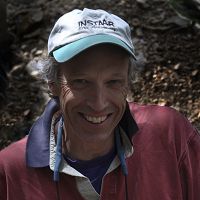Winchell and Anderson, 2017
Gophers as geomorphic agents in the Colorado Front Range.
Winchell, E.W., Anderson, R.S., (2016)
Geomorphology 264: 41-51
-
Boulder, INVESTIGATOR
-
Boulder, GRAD STUDENT
Abstract
Gophers are significant geomorphic agents in many landscapes. We document activity of the northern pocket gopher (Thomomys talpoides) in two small subalpine meadows (1050–1800 m2) of the Front Range, Colorado, USA. We tracked locations and volumes of mounds and subnivean infilled tunnels over one year and probed the thickness of the biomantle within one meadow. We infer that only 5–7 gophers occupied each meadow, implying a gopher density of 28–67 ha− 1. Fractional areal coverage of the meadows by diggings suggests that within 49–95 years gophers would fully resurface the meadows. Annual volumes of excavated soil correspond to the equivalent of ~ 1 mm of material spread evenly over the meadows. Probed meadow resistance depths reveal a pattern we interpret to be stone lines at roughly 15 cm depths; implied vertical turnover times are therefore roughly 150 years. These spatial and temporal patterns imply that gophers should be able to churn the biomantle on approximately century timescales and should fully resurface the meadow areas in similar timescales. These field data also contribute to an investigation of lateral sediment transport; given the local slope of the landscape, gopher-driven sediment transport within our two study sites suggests a landscape diffusivity of 0.008 m2y− 1. At no time do gophers occupy the forest. As evidenced by subnivean infilled tunnels, winter activity is restricted to the upslope (and hence upwind) meadow edges, which correspond to high snow cover and warm (>~0 °C) shallow subsurface soil temperatures. Subsequent activity expands downhill into the meadows and shows a distinct pulse of mound activity in late summer through early fall prior to snowfall. Local forest fire history has led to much more extensive meadows in the past, suggesting that the geomorphic influence of gophers in the landscape is much more widespread than the present distribution of meadows and may cover the entire subalpine region of the Front Range on millennial timescales.
Citation
Winchell, E.W., Anderson, R.S., (2016): Gophers as geomorphic agents in the Colorado Front Range . Geomorphology 264: 41-51.
 This Paper/Book acknowledges NSF CZO grant support.
This Paper/Book acknowledges NSF CZO grant support.
Explore Further


